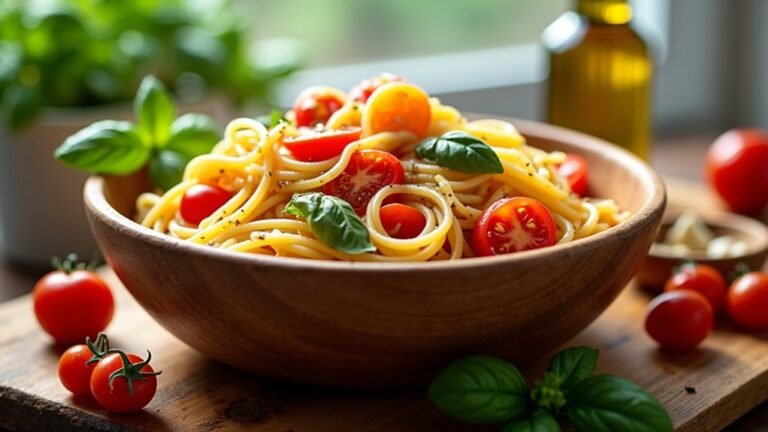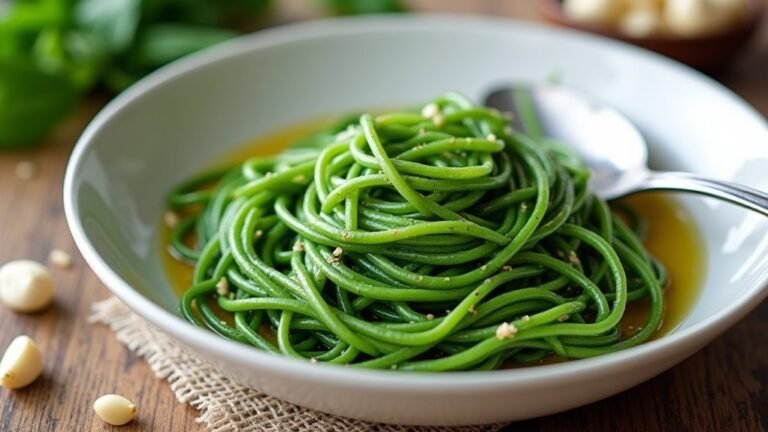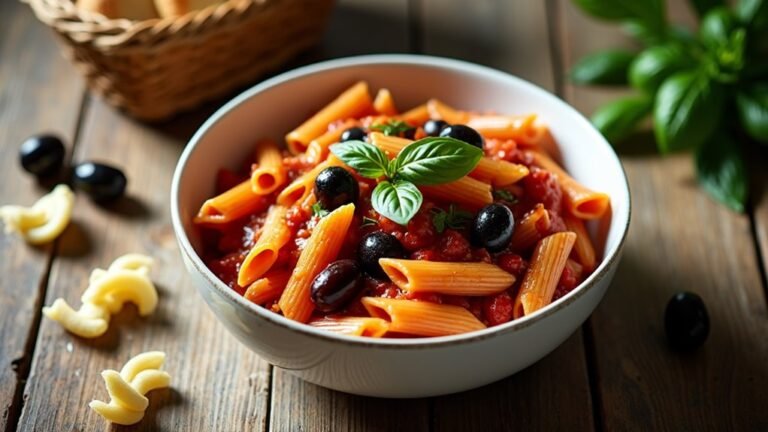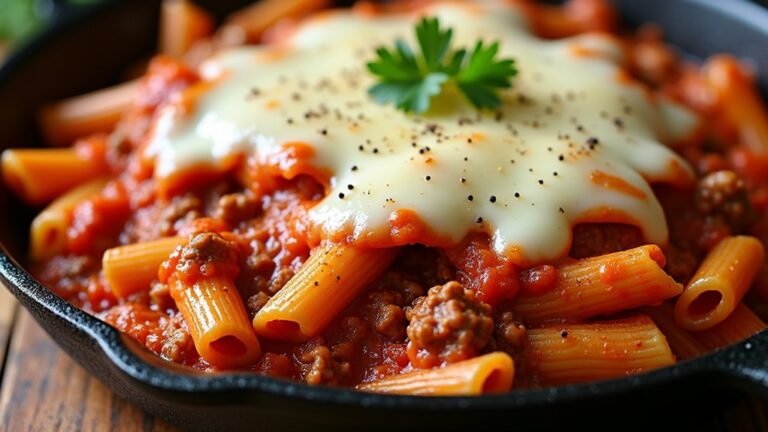Trofie With Pesto Recipe: An Italian Delight
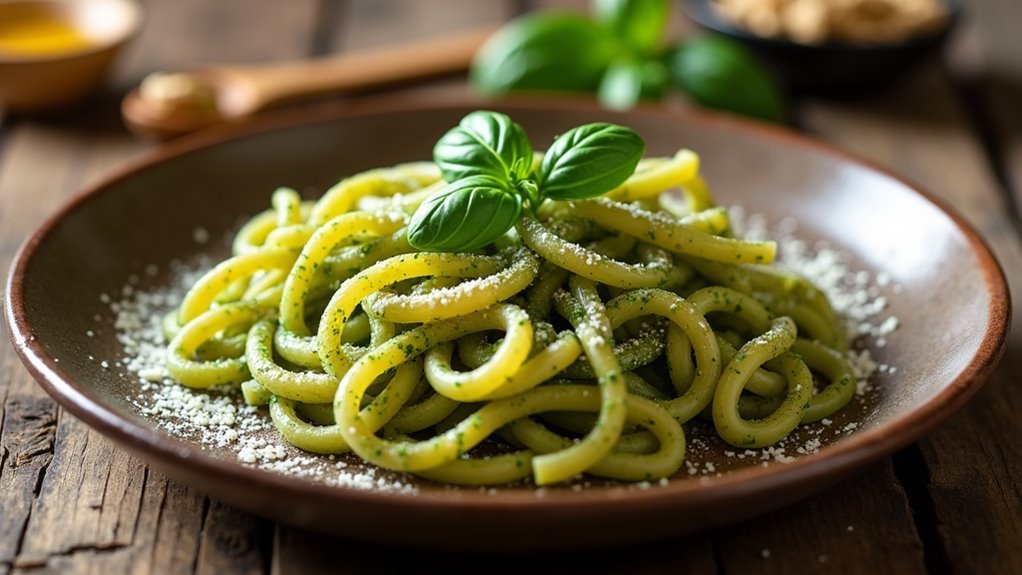
As you contemplate dinner, Trofie with pesto emerges as a simple yet refined Italian choice. This dish, featuring twisted pasta and aromatic basil pesto, captures Ligurian cuisine's essence.
You'll see how easily basic ingredients can create a comforting and elegant meal. As you think about the process—from boiling to tossing—you'll soon discover how to achieve a perfect flavor balance.
Key Takeaways
- Trofie with pesto is a Ligurian pasta dish featuring fresh basil, pine nuts, and Parmigiano-Reggiano cheese.
- Prepare pesto by blending basil, pine nuts, cheese, and olive oil for a smooth consistency.
- Cook trofie pasta until al dente and toss with the prepared pesto sauce.
- Adjust sauce with reserved pasta water for desired consistency and flavor adherence.
- Store any leftover pesto in an airtight container with a layer of olive oil on top.
Recipe
Trofie with pesto is a delightful dish that showcases the vibrant flavors of fresh basil combined with the nutty richness of pine nuts and the savory taste of Parmigiano-Reggiano cheese. This Ligurian specialty isn't only visually appealing with its twisted shape but also serves as a perfect canvas for the smooth, aromatic pesto sauce. Originating from Genoa, this pasta dish is a beloved choice in Italian coastal cuisine, offering a quick yet sophisticated meal option.
To begin, gather all the necessary ingredients to create this traditional Italian masterpiece. The pesto sauce is the star of the dish, made from fresh basil leaves blended to perfection with toasted pine nuts, Parmigiano-Reggiano cheese, and extra virgin olive oil. The trofie pasta itself, with its unique texture, is cooked until it reaches an ideal al dente consistency, ensuring each bite is both flavorful and satisfying.
Ingredients:
- Trofie pasta (500g)
- Fresh basil leaves (2 cups)
- Pine nuts (1/2 cup)
- Parmigiano-Reggiano cheese (1 cup, grated)
- Extra virgin olive oil (1/2 cup)
To prepare the dish, start by bringing a large pot of salted water to a boil and cook the trofie pasta according to the package instructions until al dente, typically 1-2 minutes less than regular pasta.
While the pasta is cooking, use a food processor to blend the basil leaves, pine nuts, and grated cheese. As the mixture blends, slowly drizzle in the olive oil until a smooth pesto sauce forms.
Once the pasta is cooked, drain it while reserving a small amount of pasta water, and return the pasta to the pot. Add the pesto sauce and toss the pasta thoroughly to coat, using the reserved pasta water as needed to reach the desired consistency.
For best results, consider toasting the pine nuts lightly before blending to enhance their flavor. The pesto sauce can be prepared in advance and stored in an airtight container with a thin layer of olive oil to prevent oxidation.
Remember that the starch in the reserved pasta water helps the pesto adhere better to the pasta, so don't skip this step. Enjoy this dish as a quick weeknight dinner or as a special treat for any occasion.
Cooking Steps
Let's get cooking! Start by bringing a large pot of salted water to a rolling boil, and while that's happening, blend fresh basil leaves and pine nuts in a food processor, adding olive oil gradually to create a smooth pesto.
Once your trofie pasta is perfectly cooked and drained, make sure to save some of that starchy pasta water, then toss the pasta with your vibrant pesto, adjusting the sauce with the reserved water to achieve the perfect consistency.
Step 1. Boil Salted Water
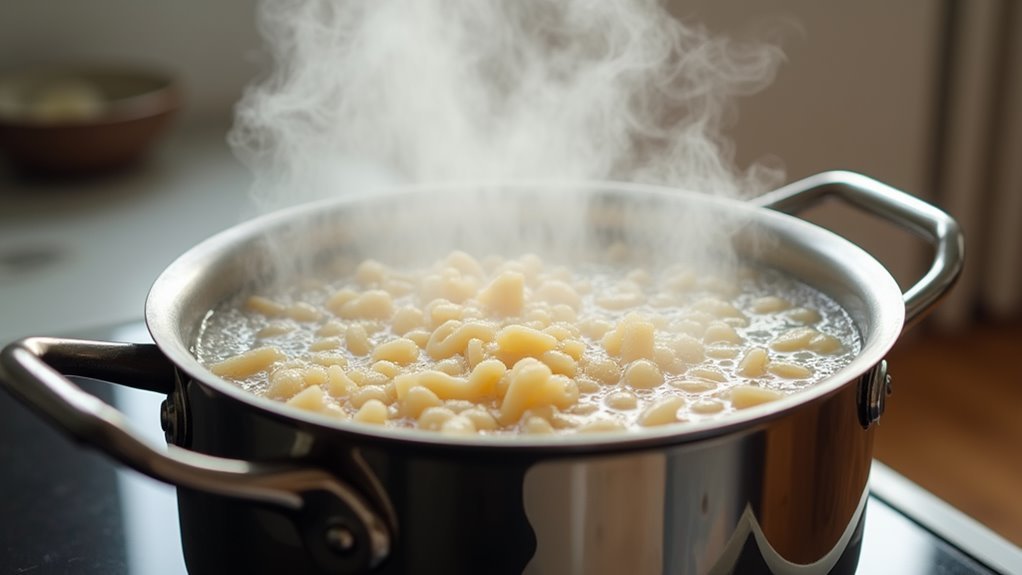
A crucial step in preparing trofie with pesto is bringing a large pot of salted water to a vigorous boil. This simple action sets the stage for the pasta to achieve that perfect al dente texture.
Don't skimp on the salt; it's your chance to season the pasta from the inside out. Imagine the excitement as the water bubbles energetically, creating a lively dance of anticipation.
The trofie will soon twirl in this bubbling bath, absorbing the saltiness that complements the rich pesto. Keep that pot covered initially to expedite the boiling process, but once it's rolling, uncover it to prevent overflow.
This boiling ritual isn't just a step; it's the foundation of a delightful culinary adventure!
Step 2. Blend Basil and Pine Nuts
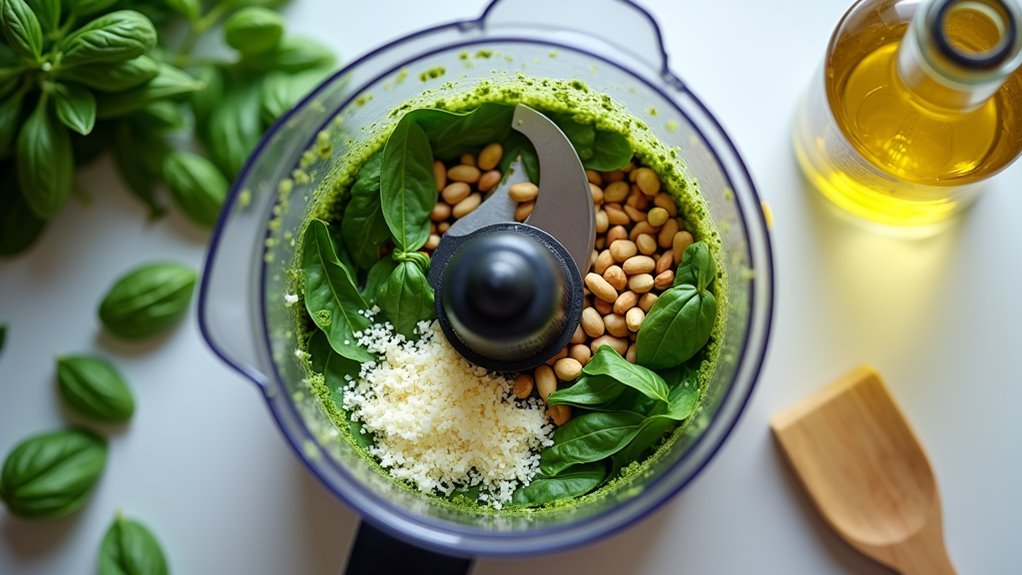
To create the pesto sauce, start by placing fresh basil leaves and pine nuts into your food processor. You'll love how the vibrant basil aroma fills your kitchen as you blend these ingredients.
Add a pinch of salt to enhance their natural flavors, then pulse until the mixture becomes a coarse paste. Don't rush this step; let the food processor work its magic, transforming these simple ingredients into a luscious base for your pesto.
Next, add grated Parmigiano-Reggiano cheese, infusing the mixture with its rich, nutty essence.
Begin drizzling in extra virgin olive oil, allowing it to emulsify with the basil and nuts, creating a smooth, creamy consistency. The olive oil's fruity notes will elevate your pesto to a delightful harmony.
Step 3. Drain and Reserve Pasta Water
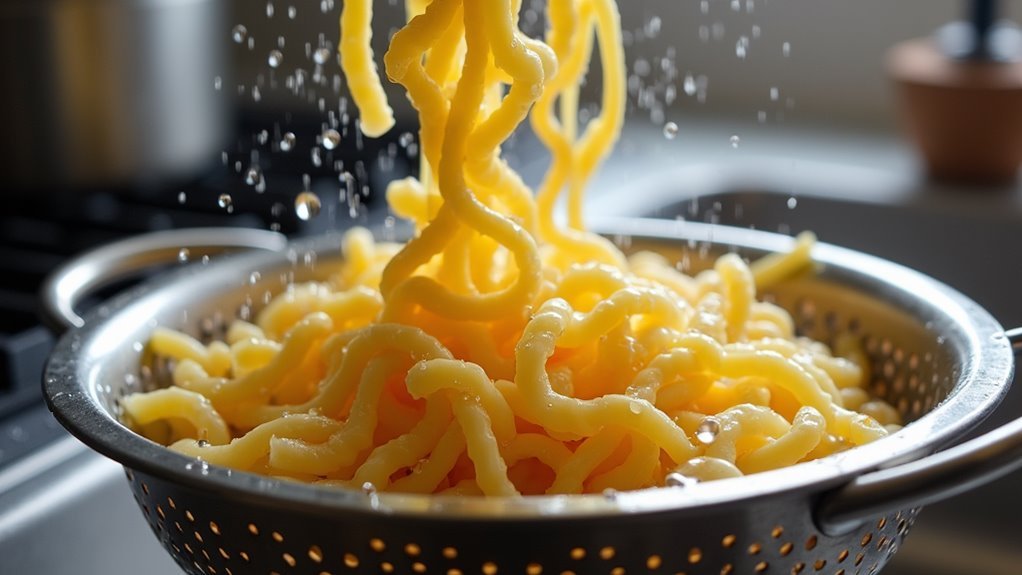
As your trofie pasta approaches that perfect al dente texture, it's crucial to act promptly. Grab a heatproof mug or measuring cup and scoop out some of the starchy pasta water before draining. This liquid gold is essential for creating a silky, well-emulsified pesto sauce later on.
Once you've reserved your pasta water, confidently drain the rest, letting the steam rise like a chef in action.
Keep the pasta in the pot, ready for the next delicious step. The reserved water will help the pesto cling to each twisted trofie strand, enhancing flavors and ensuring a creamy consistency.
This small, simple act transforms your pasta into a true Italian delight, inviting you to savor each aromatic bite.
Step 4. Toss Pasta With Pesto
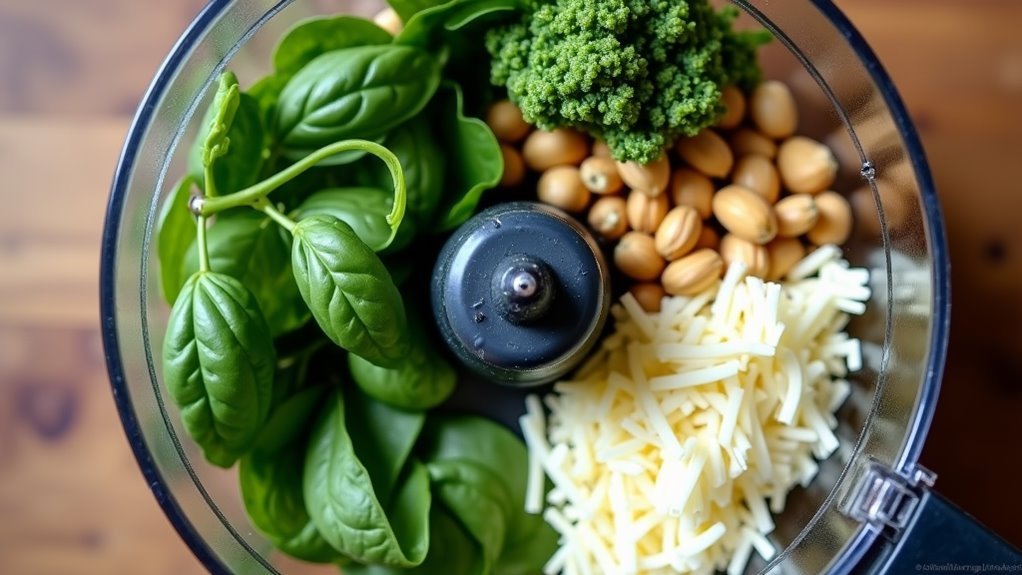
How do you transform simple ingredients into a masterpiece? By tossing freshly cooked trofie with vibrant pesto, you create an Italian delight right in your kitchen.
Once you've drained the pasta, return it to the pot and add your luscious pesto sauce. The aroma of fresh basil, the nutty hint of pine nuts, and the richness of Parmigiano-Reggiano will instantly fill the room.
Use a gentle hand to toss, ensuring every twist and turn of the trofie is lovingly coated with the sauce. The even distribution of pesto will enhance every bite, uniting the pasta and sauce into a harmonious symphony of flavor.
It's this simple step that elevates a humble pasta dish into something truly remarkable and satisfying.
Step 5. Adjust Sauce With Pasta Water
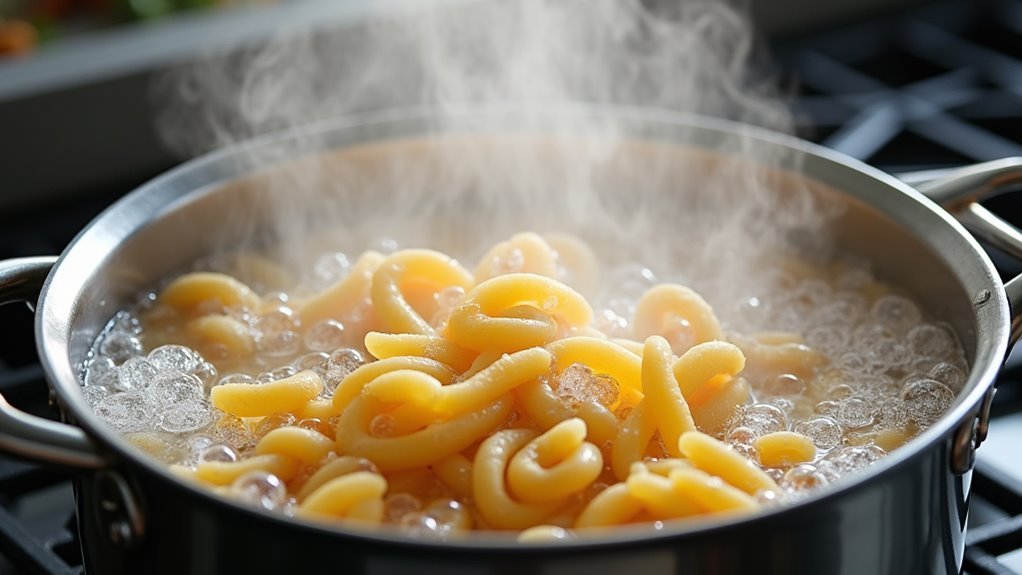
You're almost there with your Trofie with Pesto masterpiece. To make it truly exceptional, it's time to adjust the sauce with pasta water.
This step is crucial for achieving a silky, cohesive dish. As you toss the pasta with the vibrant pesto, gradually add small amounts of reserved pasta water. The starchy water helps bind the sauce to the pasta, ensuring every twist of trofie is coated with the delightful basil and cheese blend.
Add the water slowly, stirring continuously, until you reach that perfect consistency—not too thick, not too thin. This simple addition elevates the dish, making the flavors shine.
Final Thoughts
Crafting trofie with pesto is a delightful culinary journey that brings the authentic flavors of Liguria to your table. The simplicity of this dish is its charm, transforming basic ingredients into a vibrant meal.
As you twirl the tender, twisted pasta in the aromatic pesto, each bite bursts with fresh basil, nutty pine nuts, and rich Parmigiano-Reggiano.
Don't be intimidated by the process—it's straightforward and incredibly rewarding. With just a few steps, you'll create a dish that's perfect for any occasion, impressing family and friends alike.
Frequently Asked Questions
What Is the Origin of Trofie Pasta?
You're in for a treat with trofie pasta!
Originating from the Liguria region in Northern Italy, specifically around Genoa, this pasta is a culinary gem. Its unique twisted shape is perfect for holding onto sauces, especially the beloved pesto.
Making trofie is an art passed down through generations, capturing the vibrant flavors of Italian coastal cuisine.
Dive into this tradition and experience the taste of Italy in your own kitchen!
Can I Substitute Pine Nuts With Another Type of Nut?
Sure, you can substitute pine nuts with different nuts like walnuts or almonds.
These alternatives bring their own unique flavors, adding a delightful twist to your pesto. Just lightly toast the nuts to enhance their taste before using them.
You'll find that walnuts provide a rich, earthy flavor, while almonds offer a mild, sweet note.
Experimenting with these substitutions can make your pesto both exciting and personalized to your taste!
How Should I Store Leftover Trofie Pasta?
Did you know that 40% of food waste comes from households?
You can store leftover trofie pasta in an airtight container in the fridge for up to three days. To keep it fresh, drizzle a little olive oil over the pasta before sealing it.
When you're ready to enjoy it again, simply reheat in a skillet with a splash of water or broth, and stir until warmed through. Enjoy your delicious meal!
Is There a Gluten-Free Version of Trofie Available?
You're in luck! You can find gluten-free versions of trofie at many specialty stores or online.
These alternatives are often made with rice or corn flour and maintain that delightful twisty shape.
When you cook them, keep an eye on the texture; they may require a slightly different cooking time to reach al dente.
Just imagine enjoying this Italian classic without the gluten worry—it's an experience you won't want to miss!
What Wine Pairs Well With Trofie and Pesto?
Picture a gentle breeze sweeping through a sunlit vineyard, where the perfect wine awaits to complement your trofie with pesto.
A crisp, vibrant Vermentino from Liguria or a zesty Sauvignon Blanc will enhance the basil's freshness and pine nuts' richness.
These wines, with their lively acidity, dance gracefully alongside the flavors, transforming your meal into a culinary symphony.
Take a sip, savor the harmony, and let your taste buds celebrate.



